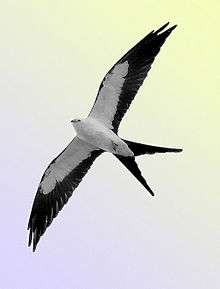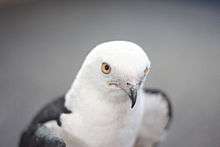Swallow-tailed kite
- For the African species, see African swallow-tailed kite
| Swallow-tailed kite | |
|---|---|
 | |
| Scientific classification | |
| Kingdom: | Animalia |
| Phylum: | Chordata |
| Class: | Aves |
| Order: | Accipitriformes |
| Family: | Accipitridae |
| Genus: | Elanoides Vieillot, 1818 |
| Species: | E. forficatus |
| Binomial name | |
| Elanoides forficatus | |
| Subspecies | |
| |
| Synonyms | |
|
Elanus forficatus (Linnaeus, 1758) | |
The swallow-tailed kite (Elanoides forficatus) is a pernine raptor which breeds from the southeastern United States to eastern Peru and northern Argentina. It is the only species in the genus Elanoides. Most North and Central American breeders winter in South America where the species is resident year round. It was formerly named Falco forficatus.
Taxonomy and systematics
The swallow-tailed kite was first described as the "swallow-tail hawk" and "accipiter cauda furcata" (forked-tail hawk) by the English naturalist Mark Catesby in 1731.[2] It was given the binomial scientific name Falco forficatus by Carl Linnaeus in the 10th edition of Systema Naturae, published in 1758;[3] he changed this to Falco furcatus in the 12th edition of 1766.[4] The latter spelling was used widely during the 18th and 19th centuries, but the original spelling has precedence. The genus Elanoides was introduced by the French ornithologist Louis Jean Pierre Vieillot in 1818.[5][6] The name is from Ancient Greek elanos for "kite" and -oides for "resembling".[7]
Description

The species is 50 to 68 cm (20 to 27 in) in length, with a wingspan of approximately 1.12–1.36 m (3.7–4.5 ft). Male and female individuals appear similar. The body weight is 310–600 g (11–21 oz).[8][9] The body is a contrasting deep black and white. The flight feathers, tail, feet, bill are all black. Another characteristic is the elongated, forked tail at 27.5–37 centimetres (10.8–14.6 in) long, hence the name swallow-tailed. The wings are also relatively elongated, as the wing chord measures 39–45 cm (15–18 in). The tarsus is fairly short for the size of the bird at 3.3 cm (1.3 in).[10]
Young swallow-tailed kites are duller in color than the adults, and the tail is not as deeply forked.
Habitat and behavior

The Swallow Tailed Kite is largely associated with large tracts of wetland forests which accommodates the birds nesting habits. Loblolly pines are the most prevalent choice for building nests but bald cypress (Taxodium distichum) are also used when the pines are unavailable. The major requirement of these nesting sites are food availability and tree height. Nesting locations are often found is trees as high as 100ft. Historic ranges in the United States covered the majority of the Southern states and much of the Midwest (As far north as Minnesota). Aside from the US, it resides in many areas throughout Central and South America. Habitat degradation and changes in wetland hydrology have caused the range to shrink in the US to just coastal regions of the southeastern and southwestern US, roughly an 80% decline in population. Swallow-Tailed kites are considered migratory raptors and during the spring months often move from areas in Central and South America to breed. Roughly 3% of the worlds population breed in the United States. [11] Traveling thousands of miles these birds move towards the most suitable nesting habitat found within coastal wetlands between the Americas. Satellite-telemetry as allowed researches to track movements of certain birds over the years and have uncovered data that supports the some migration journeys include traveling over 10,000 miles. Land located within migration routes is thought to be another concern for the kites, as deforestation and habitat degradation in Central and South Americas can have adverse affects as the birds move to breed. The birds are considered one of the most graceful fliers seen in America and often spend the majority of their lives scouring high tree tops for lizards, small mammals, and insects. The morphology of the Swallow-Tailed kite's wing and tail structure allows the bird to glide effortlessly for long distances. [12] [13] [14]
Sometimes a high-pitched chirp is emitted, though the birds mostly remain silent.
Diet
The swallow-tailed kite feeds on small reptiles, such as snakes and lizards. It may also feed on small amphibians such as frogs; large insects, such as grasshoppers, crickets; small birds and eggs; and small mammals including bats. It has been observed to regularly consume fruit in Central America.[15] It drinks by skimming the surface and collecting water in its beak. The bird usually does not break flight during feeding. [16]
Reproduction
Mating occurs from March to May, with the female laying 2 to 4 eggs. Incubation lasts 28 days, and 36 to 42 days to fledge. Often thought to form monogamous pairs, the birds are thought to spend some time apart and meet up during migrations to nesting locations. These nesting locations are often found in the highest trees in wetland areas. [17] On occasion, pairs will return to the same nesting locations of the previous years and refurbish old nests. Generally, nests take about four days to complete. [18]
Conservation in the United States
Swallow-tailed kites are not listed as endangered or threatened by the federal government in the United States. They are listed as endangered by the state of South Carolina and as threatened by the state of Texas. They are listed as "rare" by the state of Georgia.
The Center for Birds of Prey in Charleston, SC has an ongoing effort to track sightings within the state. Anonymous reports can be made at https://stki.thecenterforbirdsofprey.org or by telephone. They will also send you the summary of the years reported sightings if you leave them your contact information.
Destruction of habitats is chiefly responsible for the decline in numbers. A key conservation area is the Lower Suwannee National Wildlife Refuge in Florida. As of 2016, populations have seemed to stabilize and even show increasing trends. Successful habitat restoration and management has allowed these birds to reestablish nesting populations on areas of Georgia, Florida, and South Carolina.
References
- Sources
- Stiles and Skutch, A guide to the birds of Costa Rica ISBN 0-8014-9600-4
- Notes
- ↑ BirdLife International (2012). "Elanoides forficatus". IUCN Red List of Threatened Species. Version 2013.2. International Union for Conservation of Nature. Retrieved 26 November 2013.
- ↑ Catesby, Mark (1731). "The swallow-tail hawk". The Natural History of Carolina, Florida and the Bahama Islands, Volume 1. London. p. 4.
- ↑ Linnæi, Caroli (1758). Systema Naturae per Regna Tria Naturæ, tome 1 (in Latin) (10th ed.). Holmiæ (Stockholm): Laurentii Salvii. p. 59. BHL / Missouri Botanical Garden
- ↑ a Linné, Caroli (1766). Systema Naturae per Regna Tria Naturæ, tome 1 (in Latin) (12th ed.). Holmiæ (Stockholm): Laurentii Salvii. p. 129. BHL / Harvard University Botany Libraries
- ↑ Vieillot, Louis Jean Pierre (1818). Nouveau Dictionnaire d'Histoire Naturelle Appliquée aux Arts. Volume 24 (in French). Paris: Chez Deterville. p. 101.
- ↑ Mayr, Ernst; Cottrell, G. William, eds. (1979). Check-list of Birds of the World. Volume 1 (2nd ed.). Cambridge, Massachusetts: Museum of Comparative Zoology. p. 288.
- ↑ Jobling, James A. (2010). The Helm Dictionary of Scientific Bird Names. London: Christopher Helm. p. 144. ISBN 978-1-4081-2501-4.
- ↑
- ↑
- ↑ Raptors of the World by Ferguson-Lees, Christie, Franklin, Mead & Burton. Houghton Mifflin (2001), ISBN 0-618-12762-3
- ↑ https://dc.statelibrary.sc.gov/bitstream/handle/10827/11034/DNR_Species_Swallow-tailed_Kite_2005.pdf?sequence=1
- ↑ http://www.swallow-tailedkites.org/
- ↑ http://fwcg.myfwc.com/docs/Swallow_Tail_Kite_Habitat_Requirements.pdf
- ↑ https://dc.statelibrary.sc.gov/bitstream/handle/10827/11034/DNR_Species_Swallow-tailed_Kite_2005.pdf?sequence=1
- ↑ Buskirk, William; Margaret Lechner (October 1978). "Frugivory by Swallow-Tailed Kites in Costa Rica". The Auk. 95: 767–768.
- ↑ https://www.allaboutbirds.org/guide/Swallow-tailed_Kite/lifehistory
- ↑ https://www.allaboutbirds.org/guide/Swallow-tailed_Kite/lifehistory
- ↑ https://www.allaboutbirds.org/guide/Swallow-tailed_Kite/lifehistory
External links
| Wikimedia Commons has media related to Swallow-tailed kite. |
| Wikispecies has information related to Elanoides forficatus |
| Wikisource has original text related to this article: |
- "American Swallow-tailed Kite media". Internet Bird Collection.
- 5 pictures of Swallow-tailed Kites at amazilia.net
- Stamps (for Grenadines of Guyana, Guyana, Nicaragua) with Range Map at bird-stamps.org
- Swallow-tailed Kite photo gallery at VIREO (Drexel University)
- Photo of soaring Swallow-tailed Kite at cayaya-birding.com
- Swallow-tailed Kite species account at NeotropicalBirds (Cornell University)
- Interactive range map of Elanoides forficatus at IUCN Red List maps
- Illustration in Histoire naturelle des oiseaux de l'Amérique Septentrionale (1807).
- Description by Vieillot (1818) of Milan de la Caroline and Milan Yetapa du Paraguay, and the original designation of Elanoïdes (in French).
- Illustration in Lesson's Traite d'Ornithologie (1831).
